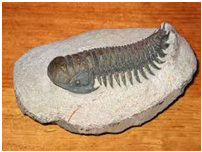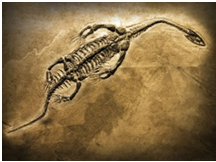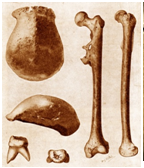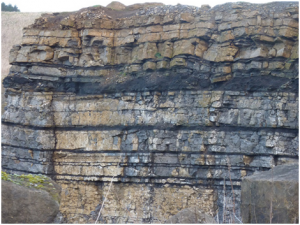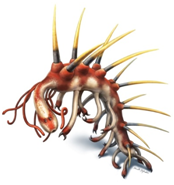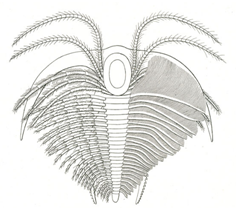Evolution and its Adversaries (Part-6)
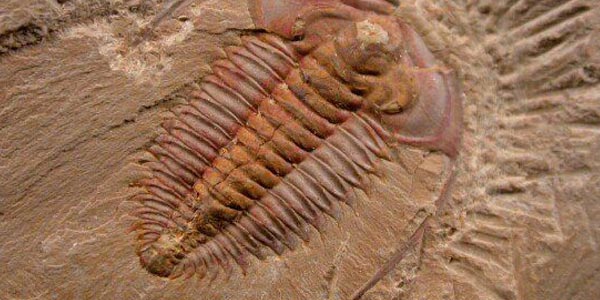
By the beginning of the last century the walls of the evolutionary citadel had begun to crack. By the end of the century they had crashed. Cambrian fossils came out of their grave and gave Darwinism the death blow, writes SYED IQBAL ZAHEER in this sixth installment of his series on Evolution.
Links missing in Fossils
Fossils are remains or impressions of past life preserved in rock, soil or amber in petrified form. Generally, the remains were once the hard parts of an organism, such as bones and shells. But with development in techniques soft fossilized tissues have also been recovered. There are different types of fossils as the remains have been preserved in a variety of ways.
There are many dating methods. Nearly all of these methods make use of radioactive elements that occur naturally in various types of minerals and organic matter.
To make it sure, several different methods are used to determine the geological era, and each method is repeated to confirm the results and improve accuracy. Careful collection of samples (avoiding contamination), rigorous crosschecking and the use of newer techniques help in dating minute samples.
Scientists have decided to consider only those remains as ‘fossils’ that are over 10,000 years old. But, in truth, it is millions of years old fossils that attract the attention of paleontologists.
The oldest period is called pre-Cambrian which starts from the beginning of life (3.6 billion years ago), lasting until about 550 million years ago. This epoch is followed by the Cambrian period which lasted from 541 until 485 million years ago. Then comes the Silurian period,lasting between 445-415 million years ago; until, (but ignoring many in between), the Tertiary period,lasting between 65 to2 million years ago.
Some Fossils
Darwin had claimed that that the missing links between one species and another would be found in fossils yet to be discovered. But his much sought after fossils, when collected, scientifically dated and analyzed, proved to be a huge disappointment for him and, down to this day, forthe evolutionists. Although thousands of fossils had already been discovered before Darwin, (studied under a new discipline called ‘paleontology’), had been sorted, classified, and dated, the discipline was still not very well known to the common public. Scientists, however, were quite familiar with it, and realized its importance. The foremost paleontologist of Darwin’s time was Louis Agassiz (1807-1870). He was:
One of the great scientists of his day, and one of the “founding fathers” of the modern American scientific tradition, Louis Agassiz remains something of a historical enigma. A great systematist and paleontologist, a renowned teacher and tireless promoter of science in America… (http://www.ucmp.berkeley.edu /history/agassiz.html)
Darwin sent a copy of his “Origin of Species” to Agassiz. But he, being a naturalist of a first order, who knew the fossil record better than any man alive in his time, was least impressed by the work. To make a factual statement, he rejected the theory outright. Agassiz’s main point was that the fossil record contradicted the evolutionary claims. Fossil record of sudden appearance of well-developed life-forms, with no precedence in the pre-Cambrian period indicated that they sprang into existence, as if from nowhere, as if instantaneously, and, consequently, posed a challenge to the concept of gradual evolutionary changes. Although hundreds of thousands of fossils of the Cambrian age were discovered by the paleontologists, the intermediary forms were completely missing. He wrote his observations to Darwin, and tried to argue him out. But he was speaking science per se while Darwin was using abstract scientific ideas as his shield. Agassiz was a thorough empirical scientist, adept at geology, ichthyology, comparative anatomy, taxonomy who, in one year alone, had collected 91,000 specimens, and had identified close to 11,000 new species. (Stephen Myers, Darwin’s Doubt, p.21). He did not reject Darwin’s speculations from an armchair position. He had well researched data with him. More.He made investigative travels and, “… made a research voyage retracing Darwin’s trip to the Galapagos Islands, to ascertain facts.” As a result of the study tour, he was more than ever convinced that Darwin’s theory was spooky.
Darwin was no match to Agassiz’s learning and admitted that he, Agassiz, was equivalent of three scientists. Darwin also accepted the validity of Agassiz’s argument, but was too far advanced in popularity to retract. His retraction would have meant his life’s failure.
Agassiz was not alone. Leading paleontologists of the time were voicing the same opinion. Another pioneering explorer of fossils was Adam Sedgwick (d. 1873). He was“…one of several great figures in what has been called the Heroic Age of geology.” (www.ucmp.berkeley.edu/history). He also thought that Darwin had leapt beyond the evidence. To be precise, he accused Darwin in a letter: “You have deserted – after a start in that tram-road of all solid physical truth – the true method of induction.” (Ibid, p.13) That was a terrible remark to make, but, by then Darwin had developed a fossilized mind. Further, he was not going to shed his false feathers of fame. He had with him a cabal of scientist, philosophers, and a caravan of elites, who, as ever, were clueless about the scientific nature of the issue. Sedgwick’s personal observation, after long studies, was that many animals with novel body parts, appeared as suddenly in the past, as suddenly new and completely different animals appeared in the next phase. This was quite strange. One would expect slightly modified animals to appear after every new geological phase. But that had not happened at all. Instead, the whole lot of a phase seemed to have been consigned to oblivion, their position taken by entirely new classes. The intermediaries were completely missing. But Darwin’s caravan was getting thicker, gaining blind followers over the continents. His followers would never make a compromise even if Darwin did. One of them was so completely given to the idea, and defended Darwin so hoarsely that he came to be known as the ‘barking dog of Darwin.’
At all events, whatever said by other scientists, the Darwinists stuck to their guns. After a talk by Niles Eldredge, an American biologist, paleontologist, a curator at the National Museum of Natural History, and a co-researcher with Stephen J Gold, a reporter stated in his report that the problem had not gone away:
“If life evolved into its wondrous profusion of creatures little by little, Dr.Eldredge argues, then one would expect to find fossils of transition creatures which were a bit like what went before them and a bit like what came after. But no one has yet found any evidence of such transitional creatures. This oddity has been attributed to gaps in the fossil record which gradualists expected to fill when rock strata of the proper age had been found. In the last decade, however, geologists have found rock layers of all divisions of the last 500 million years and transitional forms were not contained in them” (The Guardian Weekly, as quoted in Darwinism: a Theory in Crisis, p. 194)
Michael Denton, a micro-biologist and a medical doctor, adds:
Many other authorities have also recently expressed skepticism over the gradualistic philosophy, enshrined in the views of Heilman and Ostrom, arguing that it cannot account for the major innovations of evolution in a fully plausible and comprehensive manner. – (as quoted from Panda’s Thumb by Denton, Evolution, a Theory in Crisis, p. 229)
This early crisis of holding on against scientific evidences, with thin and slippery hypothesis and religious grittiness, disgusted many. Louis Agassiz had warned:
“… It is my belief that naturalists are chasing a phantom, in their search after some material gradation among created beings, by which the whole Animal Kingdom may have been derived by successive development from a single germ, or from a few germs.” (Louis Agassiz, as quoted in Darwinism: a Theory in Crisis, p. 94)
His words proved to be prophetic.
Burgess Shale Fossils
Darwin’s theory of evolution rested on three cardinal principles:
(a) Randomly obtained variations in biological life-forms;
(b) The ability of life-forms to inherit the variations obtained by the previous generations; and, finally,
(c) Competition for survival (leading to the fittest surviving and others perishing).
Darwin argued, without offering a single example, that the above happening cumulatively over millions of years had given rise to new species.
Darwinian explanation offered the theory that for a single-celled animal to develop into a multi-celled organism – say the simplest of insects – by the process of natural selection, involving, perhaps thousands of step-by-step changes, stretched over millions of years during which, numerous failed biological trials would have taken place. Consequently, fossil excavations would reveal the evidence.
Fossil Discoveries
The most ancient fossils are from the Precambrian times. Precambrian time covers the vast bulk of the Earth’s history, starting with the planet’s creation about 4.5 billion years ago and ending with the emergence of complex, multi-celled life-forms almost four billion years later. That is, from the date of appearance of the first single-celled animals (the bacteria), until about 550 million years ago,no other life form is detectable in terms of fossils. To put it differently, throughout this period of 3.15 billion years, evolution sat idleplaying no role. The earliest bacterium has, nonetheless, survived another 550 million years, down to this day, without any evolutionary change. It still has none of the features of a multi-celled organelle.
Bacteria: these are tiny single-celled animals which do not have a digestive system.
It was during the Cambrian period (starting some 550 million years ago) that fossils of multi-celled animals began to appear.Consequently, and, in view of assertions by the evolutionary scientists, it was reasonable to expect that remains of life-forms between the single-celled animal, (of the Precambrian period), and the highly complex animals, such as insects (of the Cambrian period), should be found buried in the rocks, along with many other, perhaps millions of other missing links. The Darwin’s asserted that they were simply awaiting excavation.
A simple insect. It possesses a digestive system
Nevertheless,when fossils of the Cambrian epoch were discovered, it was a matter of great disappointment for the evolutionary biologists. The discovery – of several hundred thousand fossils –not only failed the expectations but, in addition, created new problems. The missing links remained the missing links. Let alone thousands, not a single animal fossil could be discovered that could be called a predecessor of a Precambrian ancestor.The two were, in terms of life forms, as far apart biologically, as the earth and the moon physically.
Rock strata: Different layers of rocks are dated as belonging to different ecological epochs which helps in dating the age of the fossils.
One of the best fossil discoveries of the Cambrian epoch (541-485 million years ago) has been the Burgess Shale of North America. They were first discovered by an American Paleontologist called C.D. Walcott. After an accidental find, he dug tirelessly for 17 years between the years 1907 and 1924 at a site in Canada later named after a nearby mountain as the ‘Burgess Shale.’ From this Cambrian site, about 505 years old, he recovered 65,000 fossil specimens. These fossils:
“.. have been called the world’s most significant fossil discovery, mainly because of their great age, their diversity and the incredible detail of their preservation. What makes them different from other fossil sites is that a series of geological factors resulted in these soft-bodied animals (mostly arthropods) having not only the hard parts of their bodies – bones, shells, teeth – but also the muscles, gills, digestive systems and other soft body parts preserved allowing scientists an unprecedented opportunity to observe not only these details but also the way the creatures lived and interacted.” (www.burgess-shale.bc.ca/)
Animals of the Cambrian epoch
Walcott was followed by another scientist, a Harvard professor Percy Raymond who initiated another investigation at the same site and brought out thousands of specimen fossils.
An insect as reconstructed by Percy Raymond
(http://burgess-shale.rom.on.ca/en/history/discoveries/03-raymond.php)
Then a third scientist, Harry Whittington, followed suite to the Burgess Shale site in 1967 and made a series of remarkable discoveries. With a better study of the Cambrian fossils, he made the most important discovery (presented in a publication of 1971) that Walcott had wrongfully lumped together “all Cambrian forms into a few preexisting taxonomic categories.” Other scientists have defended Walcott by saying that he was, after all, a paleontologist and geologist, and not an expert in taxonomy – and so must be excused for his errors in judgment.
Findings
The first noticeable phenomenon that not even a non-biologist can miss to notice is that in comparison to the pre-Cambrian fossil discoveries, after extensive excavations conducted over the entire planet, the number of forms of life are unaccountably large during the Cambrian period. To put it differently, an observable fact of the pre-Cambrian period (lasting above 2 billion years) is that the life-forms of this period can be counted, all considered, on fingers. But the life-forms of the Cambrian period number in thousands.
Another, and an amazing finding, is that the ancestors of virtually all life forms on Earth, existing and extinct, can be found in the Burgess Shale. Quickly following this amazement is another stunning fact that there appear in this collection, fossils which are unrelated to any current living forms. That is they appear in these fossils, but, amazingly, have disappeared altogether, in later, Cambrian fossil discoveries. But the biggest mystery of all is that life-forms appearing in the Burgess Shale collections have no precedence in the pre-Cambrian discoveries. That is, ancestors of the life-forms of the Cambrian epoch (about 540 million years ago), are completely missing in the discoveries of the epoch immediately preceding it, that is, the pre-Cambrian epoch.(http://science.nationalgeographic.com/)
The evolutionary belief is that the modifications in life-forms have been bit-by-bit over numerous generations. To put it simply, a soft-bodied animal made of tissues alone, cannot give birth to an animal with a bone structure, in one go. If it ever happens, it would be no less than a miracle, attributable to an Intelligent Agency. Rather, there must be numerous in-between life forms, represented in the fossil collections. Geologists, however, found no such myriad of transitional forms leading to the Cambrian fauna. Instead, the stratigraphic column seemed to document the abrupt appearance of the earliest animals.
Many scientists have raised these intriguing questions without being able to obtain any satisfactory answer from the evolutionists. Darwin had realized the seriousness. He had noted in the Origin,
“Theabrupt manner in which whole groups of species suddenly appear in certain formationshas been urged by several paleontologists—for instance, by Agassiz, Pictet, andSedgwick—as a fatal objection to the belief in the transmutation of species. Ifnumerous species, belonging to the same genera or families, have really started into lifeall at once, the fact would be fatal to the theory of descent with slow modificationthrough natural selection.” (Darwin’s Doubt, p. 17).
But he kept his hope alive in later fossil findings to answer these questions, primarily, what happened to the missing links.
The Chinese Connection
As years passed, another major site of fossils belonging to the Cambrian age was discovered in 1995. This time it was far away in southern China. The site, known as Maotianshan Shale, yielded fossils of unique animals not found in Precambrian epoch such as: a hard shell covering the body, digestive system, a primitive heart, neural cords with brains, heads with possible eyes, etc. The body plan clearly showed a uniqueness not found in Precambrian fossils, with no evidence of a gradual development from any previous animal. Traces of minute changes in the fossils were completely absent. The missing links remained missing. The sudden appearance of the newest forms of life, defying the evolutionary theory of gradual change, was beginning to be as puzzling to the evolutionary biologists, as the first appearance of life itself was.
By the beginning of the last century the walls of the evolutionary citadelhad begun to crack. By the end of the century they had crashed. Cambrian fossils came out of their grave and gave Darwinism the death blow.
To sum up
A study of the fossils has raised new problems that did not challenge the theory of evolution, but have delivered it a death blow.
- “All kinds of multi-celled creatures, in astonishing variety, seemed to come at once out of nowhere,” defying the Darwinian canon that every species should have an ancestor. (http://www.panspermia.org/neodarw.htm)
- The animals of one epoch are extremely primitive, while those of the following epoch are highly advanced. If one was a farmer’s hoe, the other was a tractor; and nothing in between:“In fact, the sudden appearance of new kinds of creatures, without evidence of intermediate kinds, is more the rule than the exception.”(http://www.panspermia.org/neodarw.htm)
(To be continued)

